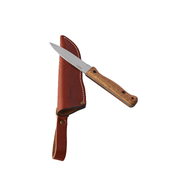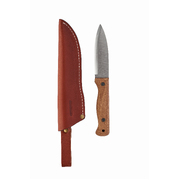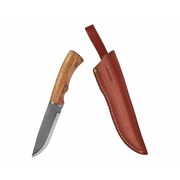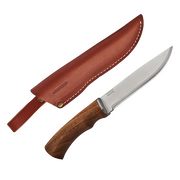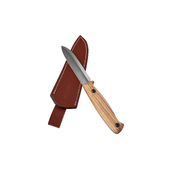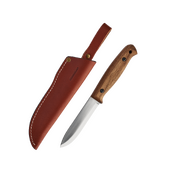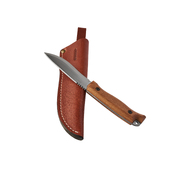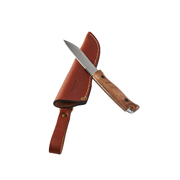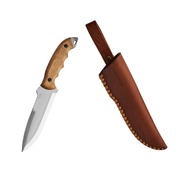CARBON STEEL VS STAINLESS STEEL KNIFE
So, carbon and stainless steel – which is better: carbon or stainless steel knives?
Before you buy cutlery, you need to think about the material of the knife and the purpose for which you need it. The choice of material is often limited to the following “confrontation” – stainless steel vs high carbon steel knives.
It is carbon steel that is most often used in forging knives. However, it is difficult to name the best type of steel unequivocally. The same carbon metal with fine grains in its structure can be sharpened quickly, but it can easily corrode.
Powder metallurgy blades (no matter which one is preferred – stainless steel vs carbon steel knife) have excellent cutting properties, but it is almost impossible to process (sharpen) the cutting part. Chemical additives can significantly change the composition of the metal. The best characteristics can be achieved by quality heat treatment of the body of the carbon vs stainless steel knife. Different manufacturers have their own ” branded” heat treatment.
Carbon steel
Carbon steel is a metal that contains carbon and iron. Metallic carbon is the main element – its percentage in the metal helps define the carbon steel classification system. The presence of carbon in steel contributes to the durability of the metal.
Carbon steel is primarily used in the development of building materials, strong steel wire, and major automotive components. Like any steel, it may also contain other alloys:
- chromium;
- silicon;
- nickel;
- vanadium.
However, these additives are quite rare and their percentage is insignificant. If you decide to choose knife carbon steel vs stainless, you need to know – the higher is the carbon content, the denser and more brittle is the steel. However, an alloy with a lower carbon content offers a stronger and more flexible metal.
But that’s not all. Adding extra compounds such as nickel or chromium increases corrosion resistance and gives the product hardness and durability. So, when choosing carbon steel vs stainless steel knives, you also need to know what other metals are in the product.
Carbon steel has a brushed surface, higher tensile strength and is much harder than stainless steel. Without a doubt, this kind of material is one of the best for a knife blade.
Such a knife is almost indestructible, even when used to cut food on metal or natural stone surfaces. It can easily be sharpened to a superior cutting edge with a sharpener or other honing tools. High-carbon steel keeps sharpening well, even with repeated use.
BPS carbon steel knives are quite durable, hold their shape very well and withstand abrasions. Examples of excellent knives made of this material can be found in our catalog:
Stainless steel
Stainless steel is a good alternative to high carbon steel because it is very durable and knives made from this material retain razor sharpness. As for the stainless steel knife vs carbon steel comparison, stainless steel has the advantage of being resistant to the stains created by chrome. Many high-end knives are made from this material and when considering a high carbon vs stainless steel knife, many users prefer it.
The term “stainless steel” is often used today, so it can be difficult to know if it really is stainless steel. But its main obvious sign is its shine due to its high chromium content, which makes it very resistant to corrosion. Stainless steel knives are usually a combination of high-carbon steel and contain 11% to 17% of chromium.
The most important characteristic is that such steel never oxidizes or rusts like other iron and steel products. This means that stainless steel lasts longer and works better in humid environments. Keep this in mind when choosing a stainless vs carbon steel knife.
СARBON STEEL KNIFE CARE – SAY NO TO RUST
Knives always require a certain level of care and maintenance so you can get the most out of them. Carbon steel knives are the tool to be chosen by both professional chefs and home use. The steel has a fairly sharp edge and retains it longer than most stainless steel options.
Carbon steel, however, is a more demanding material to care for. Therefore, owners of such a tool often wonder how to clean a high carbon steel knife. A carbon steel knife will rust if you leave it dirty or wet for long periods of time.
Here are some tips to help you stop thinking about how to care for a carbon steel knife and ensure a clean carbon steel knife:
- Keep a slightly damp towel next to the cutting board and wipe the blade when not in use. Completely wipe it dry before putting it away.
- From time to time, apply food-safe oil to the handle and blade. This helps protect the blade from rust and rejuvenates the wood of the handle.
- Wash knives by hand with soap and water. It is not recommended to wash your knives in the dishwasher. Dishwashing detergent will cause corrosion of the steel and you will probably then have to look for a solution to the problem of how to remove rust from a carbon steel knife.
- Carbon steel knives get patina as they are used, this means that the knife takes on a gray/blue-green hue where it reacted with the food it cut. The patina will help resist corrosion. If you want to know how to take care of a carbon steel knife, you need to pay attention to the color of the steel, rust and corrosion can be red, orange or brown.
- If you see rust, rub the affected areas with a sponge scrubber. Continue to do this until the rust is gone and the surface is smooth to the touch. The process of removing rust from carbon steel knife should be completed by applying a food-safe oil to the blade.
The next point on how to care for carbon steel knife is storage. Store your knives in a safe place where the blade and tip will not come into contact with surrounding objects. Knife blocks and wall magnets are great options for storing your tool safely.
Keep knives sharp. A sharp knife is a safe knife because it takes less pressure to cut, which reduces the chance of the knife slipping. Sharpen your knives on stones, not grinding wheels. These stones are much softer and give a much sharper edge for how to clean carbon steel knife. Avid home cooks and professional chefs should sharpen their knives regularly, every 1-3 months. Less inclined users should sharpen their knives 2-3 times a year.
Sharpen your knives carefully so you do not accidentally blunt the blade. So, how to clean a carbon steel knife properly? Take the sharpening stick in your non-driving hand and rest the tip on a towel or cutting board. Looking down at the tip of the knife, tilt it so that the blade touches the stick about 15 degrees. Using only the weight of the knife, sharpen the edge in one smooth downward motion from heel to tip. With each pass, change the side you are sharpening by either turning the knife upside down or gently pulling the knife to the other side of the stick. Check the tool and make sure you’ve dealt with the dilemma of how to remove rust from carbon steel knife.



